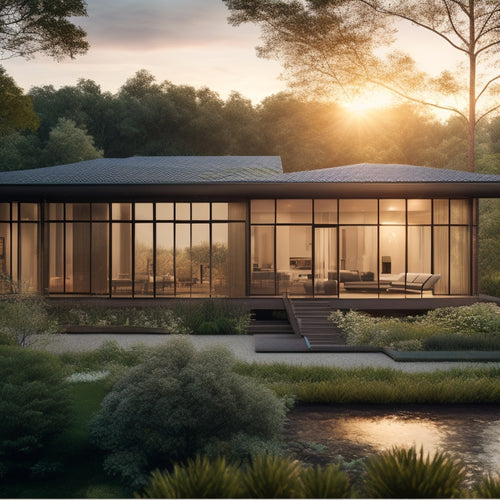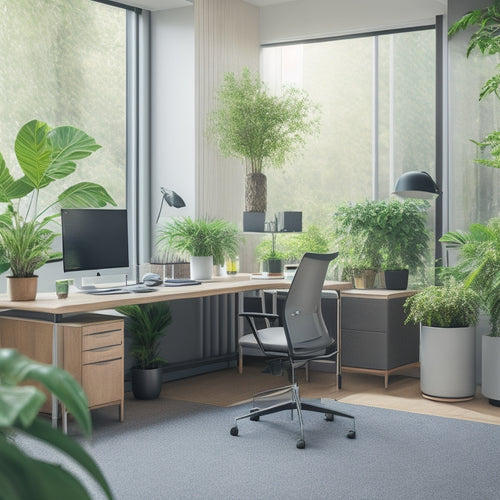
Weatherproof Your Home: Sustainable Energy-Saving Solutions
Share
You're likely wasting up to 30% of your energy consumption due to poor insulation and air leaks in your home, resulting in higher utility bills and a larger carbon footprint. To weatherproof your home, start by sealing air leaks with caulk, spray foam, and weatherstripping, and upgrade your insulation with eco-friendly materials like recycled cellulose, natural wool, or denim. Next, look into sustainable window solutions, such as double- or triple-pane windows, and efficient door systems with advanced weatherstripping. By implementing these energy-saving solutions, you'll not only reduce your energy consumption but also enhance your overall comfort and quality of life. Now, investigate the various ways to optimize your home's energy efficiency.
Key Takeaways
- Proper insulation installation, including green materials and air leak sealing, reduces energy consumption and utility bills by up to 30%.
- Energy-efficient windows, such as double- or triple-pane, and window films minimize heat loss and glare, improving overall insulation performance.
- Advanced weatherization techniques, including caulk and weatherstripping, effectively seal gaps around openings, reducing energy loss and improving comfort.
- Sustainable roofing solutions, like solar shingles and recycled metal roofing, reduce environmental impact and minimize reliance on fossil fuels.
- Efficient door systems with high R-value ratings, smart technology, and advanced weatherstripping optimize thermal performance and prevent air leaks.
Insulation Essentials for Energy Efficiency
Because a well-insulated home is key to reducing energy consumption, it's essential to understand the basics of insulation.
You'll benefit from insulation in several ways: it reduces heat loss in winter and heat gain in summer, saving you money on energy bills. Insulation also helps maintain a consistent indoor temperature, making your home more comfortable.
Radiant barriers, a type of insulation, are particularly effective in warm climates. They work by reflecting heat rather than absorbing it, reducing the amount of heat that enters your home.
Sealing Air Leaks for Maximum Savings
As you work to create an energy-efficient home, don't overlook the importance of sealing air leaks, which can account for up to 30% of heating and cooling losses.
In fact, reducing fuel consumption costs in other areas, like transportation, can have a significant impact on your overall energy expenditure.
Start by identifying areas where air leaks are most common, such as electrical outlets, switches, and windows.
Use draft sealing techniques like caulk, spray foam, or weatherstripping to seal gaps and cracks.
Assess air quality by conducting a blower door test or hiring a professional to detect hidden leaks.
Don't forget to inspect your ductwork, as leaky ducts can waste a significant amount of energy.
Eco-Friendly Window Solutions
Now that you've addressed air leaks, it's time to tackle another significant contributor to energy loss: inefficient windows. Inefficient windows can let heat escape in the winter and enter in the summer, increasing your energy bills and carbon footprint.
To combat this, consider applying window films that reflect heat and reduce glare. Additionally, many green energy electric vehicle charging stations incorporate solar panels and renewable energy sources, such as renewable energy sources, to reduce their carbon footprint. These films can be applied to existing windows, making them a cost-effective solution.
Another option is to install thermal curtains or drapes, which can help keep warmth in and cold out. These eco-friendly window solutions not only reduce energy consumption but also enhance your home's comfort and sustainability.
Sustainable Roofing Materials Matter
In tandem with eco-friendly window solutions, sustainable roofing materials play an essential role in reducing your home's environmental impact.
As you evaluate weatherproofing your home, don't overlook the importance of eco-friendly roofing options. Not only do they reduce your carbon footprint, but they can also increase your home's energy efficiency and save you money on utility bills.
By leveraging renewable energy solutions, homeowners can minimize their reliance on fossil fuels and lower energy bills. Furthermore, solar-powered roofing materials can provide a stable energy supply, reducing downtime and maximizing productivity.
Here are some sustainable roofing materials to evaluate:
- Solar shingles: These innovative shingles generate electricity while providing protection from the elements, making them an attractive option for environmentally conscious homeowners.
- Green roofs: Plant-covered roofs provide insulation, reduce stormwater runoff, and create habitats for local wildlife.
- Recycled metal roofing: Made from recycled materials, these roofs are durable, resistant to weathering, and can be recycled again at the end of their life cycle.
- Low-maintenance tile roofing: Made from sustainable materials like clay or concrete, these tiles require minimal upkeep and can last for decades.
Efficient Door Systems for Homes
Frequently, homeowners overlook the significance of efficient door systems when weatherproofing their homes, focusing primarily on roofing and windows.
However, doors play a vital role in maintaining a comfortable and energy-efficient living space. By incorporating renewable energy solutions, such as solar panels, homeowners can reduce their reliance on fossil fuels and lower their carbon footprint.
You can upgrade to smart door technology, which integrates sensors and automation to optimize thermal door performance. This can help reduce heat loss in winter and heat gain in summer, saving you energy and money.
Look for doors with high R-value ratings, indicating better insulation and energy efficiency. Additionally, consider installing doors with advanced weatherstripping, ensuring a tight seal to prevent air leaks.
Green Insulation Materials to Know
Investigate the world of eco-friendly insulation materials to guarantee your home remains cozy while reducing its environmental impact.
You'll find a range of sustainable options that not only reduce energy consumption but also minimize waste and promote eco-friendliness.
Consider the following green insulation materials:
- Recycled cellulose: Made from recycled paper products, this insulation is eco-friendly, fire-resistant, and provides excellent thermal performance.
By leveraging renewable energy sources, such as solar power, you can further reduce your carbon footprint solar-powered charging.
- Natural wool: A natural, renewable resource that provides excellent insulation and can be sourced locally, reducing transportation emissions.
As the demand for EV charging infrastructure grows, it's crucial to prioritize sustainable energy solutions, like energy storage systems, to optimize charging efficiency.
-
Cork: A sustainable, renewable resource that's resistant to moisture, mold, and mildew, making it ideal for humid climates.
-
Denim insulation: Made from recycled denim jeans, this eco-friendly option is durable, resistant to pests, and provides excellent thermal performance.
Advanced Weatherization Techniques
You'll take your weatherproofing to the next level by addressing the finer details.
Start by sealing air leaks, which can considerably reduce heat loss and energy consumption.
Next, consider upgrading to energy-efficient windows and optimizing your insulation to maximize its performance.
Seal Air Leaks
Around windows, doors, and electrical outlets, air leaks can quietly waste energy and increase your utility bills. To seal these air leaks, you'll need to identify and address the gaps and cracks where air is escaping. This is essential for maintaining good air quality and humidity control in your home.
By reducing grid reliance and incorporating renewable energy sources harnessing solar power, you can further minimize your energy consumption. Additionally, using high-efficiency inverters can optimize energy conversion and reduce overall charging costs.
- Caulk and weatherstrip: Seal gaps around windows, doors, and electrical outlets using caulk or weatherstripping.
- Foam sealant: Use foam sealant to fill larger gaps around pipes, vents, and electrical outlets.
- Spray foam insulation: Spray foam insulation can be used to seal gaps in your attic, walls, and floors.
- Weather-resistant barriers: Install weather-resistant barriers around windows and doors to prevent air leaks and water intrusion.
Energy-Efficient Windows
Upgrading to energy-efficient windows is an essential advanced weatherization technique, as old, single-pane windows can account for up to 25% of your home's heat loss.
You can consider replacing them with double- or triple-pane windows that provide better insulation. If replacement isn't feasible, applying window film can help reduce heat transfer.
Conducting energy audits can help identify which windows are the biggest culprits. You'll be able to pinpoint areas where energy is being wasted and prioritize your upgrades.
Insulation Upgrades Matter
Beyond windows, another critical area to focus on is your home's insulation, which can account for up to 30% of heat loss.
You can markedly reduce energy consumption and lower your utility bills by upgrading your insulation. Proper insulation installation provides numerous benefits, including reduced heat loss, decreased energy consumption, and a more comfortable living space.
To reap the insulation benefits, consider the following:
-
Seal air leaks: Confirm that all gaps and cracks are sealed to prevent heated air from escaping.
-
Insulate walls: Use fiberglass batts, spray foam, or rigid foam board to insulate your walls.
-
Upgrade attic insulation: Install insulation materials like cellulose, fiberglass, or spray foam to reduce heat loss.
- Insulate floors: Use insulation materials like foam board or spray foam to insulate your floors, especially over unheated spaces like garages or crawlspaces.
Frequently Asked Questions
How Often Should I Inspect My Home's Weatherproofing Systems?
As you shield your sanctuary from the elements, remember that your home's armor, weatherproofing materials, need regular checks: perform seasonal inspections to verify they're intact, protecting your freedom to live comfortably, and your wallet from costly repairs.
Can I Weatherproof My Home on a Limited Budget?
You can weatherproof your home on a limited budget by exploring DIY methods and utilizing budget-friendly materials, such as sealants, caulk, and weatherstripping, to effectively seal gaps and cracks without breaking the bank.
Are There Any Government Incentives for Weatherproofing Homes?
As you commence on weatherproofing your home, a wealth of government incentives awaits you. You can tap into federal programs, like Energy Star, and local grants, which can help offset costs, putting more green in your pocket and the environment.
Can Weatherproofing Increase My Home's Resale Value?
You'll enhance your home's resale worth by weatherproofing, as energy efficiency and property appeal increase. Prospective buyers will be drawn to your eco-friendly, cost-effective abode, making it more attractive and beneficial in a competitive market.
Do Weatherproofing Measures Require Frequent Maintenance?
You might think weatherproofing measures need constant upkeep, but the truth is, most weatherproofing materials are designed to be low-maintenance. You'll only need to perform seasonal maintenance checks to guarantee their effectiveness.
Related Posts
-

Smart Energy: Greener Homes With Connected Power Devices
You can control and optimize your energy consumption with smart energy devices, reducing your carbon footprint by up ...
-

7 Solar-Safe Window Solutions for Earth-Conscious Homeowners
As an earth-conscious homeowner, you're likely keen to find solar-safe window solutions that align with your values. ...
-

What Air Purifiers Save Energy in Work Areas?
You can cut energy costs and reduce your carbon footprint by choosing air purifiers designed with energy efficiency i...


